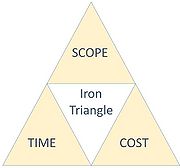Resource-Constrained Critical Path Method
Developed by Giorgia Scartozzi
This article aims to describe a new approach to a specific project management technique called Critical Path Method (CPM).
According to Project Management Body of Knowledge (PMBOK), CPM is a method used to estimate the minimum project duration and determine the amount of scheduling flexibility on the logical network paths within the schedule model[1]. Given scheduled activities for a project that need to be completed in a specific order, multiple task sequences can be defined. CPM helps us to determine the longest sequence of tasks in the project, which will be also the shorter possible project duration. Thus, the main steps of CPM will be described, providing a brief guidance on how to apply the method so to obtain the optimal project duration.
However, a traditional CPM schedule is not realistic, because it assumes unlimited resources, some of which are highly limited in practice[2]. Therefore, a different approach of the same technique, called Resource-constrained Critical Path Method (RCPM), will be presented. By providing a step-by-step RCPM procedure, the article will focus on the advantages that this method can offer compared to the traditional Critical Path Method. The paper will then conclude with observations about the benefits and limitations of both CPM and RCPM, highlighting differences and similarities between the two techniques.
Contents |
Overview
What is Project Management?
The definition of 'project' can be found in the Project Management Body of Knowledge: it is a temporary endeavor undertaken to create a unique product, service, or result[1]. Ergo, a project is any series of activities and tasks having a specific objective to be completed within some specifications[3], such as start and end dates, specific goals and limits, established implementers responsibilities, budget and schedule[4].The management of a project is essential to ensure that these activities are completed in accordance with all the given specifications and expectations[5]. Therefore, 'project management' can be defined as the application of knowledge, skills, tools, and techniques to project activities to meet the project requirements[1]. It is the process of defining, planning, organizing and controlling tasks in order to deliver a project in time and at a reasonable cost.
The project management success can be measured through the "iron triangle" model that includes time, scope, and cost. The success of a project should, therefore, be measured within project scope, scheduling, cost, quality, resource, and risk constraints in term of completing the project [6].
Scheduling is an important and difficult task during project planning since it helps to monitor the project duration and resource utilization. The challenge is about the scheduling complexity and dynamism: in fact, plans can change before the start but even during the implementation[4]. In order to better manage projects and face the changes that may occur over time, a lot of methods were created, and among them, the Critical Path Method (CPM) is one of the better-known planning and control techniques in project scheduling.
The Critical Path Method
How to use the Critical Path Method
The Resource-constrained Critical Path Method
Observations
References
- ↑ 1.0 1.1 1.2 Project Management Institute, "A guide to the project management body of knowledge (PMBOK® guide) - Fifth edition". (2013)
- ↑ Kyunghwan Kim and Jesùs M. de la Garza, "Phantom Float". Journal of Construction Engineering and Management, Volume 129, No. 5 (October 1, 2003)
- ↑ Paing Hein Soe and Thein Min Htike, "Critical Path Analysis programming method without network diagram". MATEC Web Conference, Volume 192 (2018)
- ↑ 4.0 4.1 Rafik Nafkha and Artur Wilinski, "The Critical Path Method in estimating project duration". Information Systems in Management, Volume 5, No. 1, Pages 78−87 (2016)
- ↑ Nishi Sharma and S. B. Gupta, "Applications of Critical Path Method in Project Management". International Journal of Management and Economics, Volume 1, No. 26 (November 2018)
- ↑ Arin Wulandari, M. Dachyar and Farizal, "Scheduling of Empennage Structure Design Project of Indonesia’s Aircraft with Critical Path Method (CPM)". MATEC Web Conferences, Volume 248 (2018)
